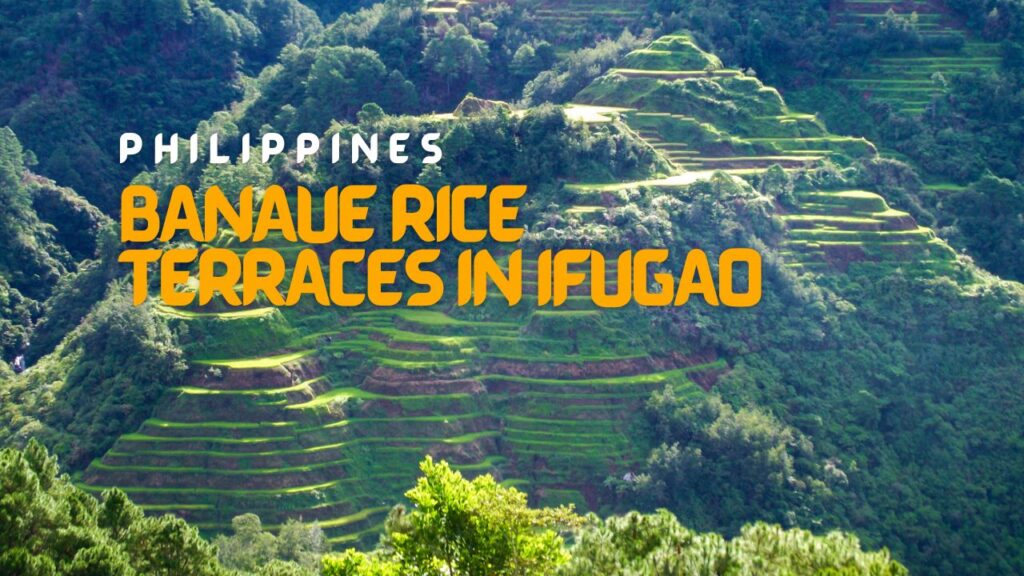Banaue Rice Terraces in Ifugao
11 min read
Banaue Rice Terraces in Ifugao: A UNESCO Heritage Site in the Philippines
The Banaue Rice Terraces in Ifugao, Philippines, are an iconic and breathtaking landscape with significant cultural and historical importance. Carved into the mountains by the ancestors of the Igorot people, these terraces are often called the “Eighth Wonder of the World.” The Ifugao people, known for their wet-rice agricultural practices, began constructing these terraces around the 1st century CE, showcasing their remarkable engineering and agricultural skills.
Stretching across the mountainous region, the Banaue Rice Terraces are a testament to the sustainable farming practices of the Ifugao community. These terraces cover approximately 10,360 square kilometers and are supported by an intricate irrigation system that utilizes water from the rainforests above the terraces. The harmonious integration of the terraces with the natural landscape reflects the deep connection between the Ifugao people and their environment, making it a site of both cultural and environmental significance.
History and Significance
The Banaue Rice Terraces are a testament to the ingenuity and resourcefulness of the Ifugao people. These terraces were carved into the mountains of Banaue, Ifugao, more than 2,000 years ago by the ancestors of the Igorot people. The Ifugao people used a system of irrigation to cultivate rice on these terraces, which allowed them to support their communities and sustain their way of life.
UNESCO World Heritage Site
The Ifugao Rice Terraces are a UNESCO World Heritage Site. This designation was given to the terraces to recognize their cultural and historical significance. The Ifugao Rice Terraces epitomize the absolute blending of the physical, socio-cultural, economic, religious, and political environment. They are a living cultural landscape of unparalleled beauty.
National Cultural Treasure
In addition to being a UNESCO World Heritage Site, the Banaue Rice Terraces are also a National Cultural Treasure. This designation was given to the terraces by the Philippine government in recognition of their cultural and historical importance. The Banaue Rice Terraces symbolize cultural identity for the Ifugao people and are a testament to their resourcefulness and ingenuity.
Living Cultural Landscape
The Banaue Rice Terraces are a living cultural landscape. They are still in use today and are essential to the Ifugao way of life. The Ifugao people have managed to maintain the terraces over the centuries, using traditional methods and techniques to keep them in good condition. Today, the terraces are not only a source of food and livelihood for the Ifugao people but also a source of pride and cultural identity.

Geography and Climate
Cordillera Region
Banaue Rice Terraces are located in the Cordillera Region of Luzon Island, Philippines. The Cordillera Region is a mountainous region that covers the provinces of Abra, Apayao, Benguet, Ifugao, Kalinga, and Mountain Province. The Cordillera Region is known for its beautiful landscapes, rich culture, and unique traditions. It is home to several indigenous groups, including the Ifugao people who built the rice terraces.
Temperature and Seasons
The Cordillera Region has a tropical climate with two distinct seasons: the dry season and the wet season. The dry season usually runs from November to April, while the wet season runs from May to October. The temperature in the region is generally cool due to its high altitude. The average temperature in the region is around 22°C (72°F) with temperatures dropping to as low as 15°C (59°F) during the coldest months of December and January.
The Cordillera Region’s climate is affected by the northeast monsoon, which brings cool and dry air from Siberia, and the southwest monsoon, which brings warm and humid air from the Pacific Ocean. The region is also prone to typhoons during the wet season, which can cause landslides and flooding.
The Ifugao province, where the Banaue Rice Terraces are located, has a similar climate to the rest of the Cordillera Region. The temperature in the Ifugao province is generally cool, and the province experiences both the dry and wet seasons. The Ifugao people have developed a unique irrigation system that allows them to grow rice in the terraces despite the region’s climate.

Agricultural Practices
Banaue Rice Terraces in Ifugao is a UNESCO World Heritage Site and a popular tourist destination in the Philippines. The terraces are a testament to the Ifugao people’s sustainable farming practices and soil conservation techniques. The agricultural practices in Banaue Rice Terraces have been passed down from generation to generation and have remained unchanged for over 2000 years.
Traditional Farming
The Ifugao people practice traditional farming techniques that involve manual labor and minimal use of machinery. The rice terraces are carved into the mountain slopes and are arranged in a series of benches following the contour of the terrain. The terraces are irrigated with water from the ancient irrigation system that has been in place for centuries. The Ifugao people use water buffalo to plow the fields and plant rice and vegetables by hand.
Irrigation System
The ancient irrigation system in Banaue Rice Terraces is a marvel of engineering and is considered one of the most advanced irrigation systems in the world. The irrigation system is composed of canals, dams, and reservoirs that are strategically placed to distribute water evenly throughout the rice terraces. The irrigation system is designed to conserve water and prevent soil erosion. The Ifugao people use a complex system of valves and gates to control the flow of water and ensure that each terrace receives the right amount of water.

Cultural Heritage
Indigenous Ifugao
The Banaue Rice Terraces in Ifugao are a living cultural landscape of unparalleled beauty that epitomize the absolute blending of the physical, socio-cultural, economic, religious, and political environment. Indeed, it is a priceless contribution of Philippine ancestors to humanity. The Ifugao people have been the caretakers of the terraces for over 2,000 years. They have developed a sophisticated system of water management that enabled them to create the terraces on the steep slopes of the Cordillera Mountains.
The Ifugao people have a rich cultural heritage that is closely tied to the rice terraces. The terraces are not just a source of food and income but also a symbol of their identity, beliefs, and values. The Ifugao culture is based on the principles of cooperation, reciprocity, and respect for nature. They have a unique worldview that emphasizes the interconnectedness of all things and the importance of maintaining harmony with the environment.
Cultural Landscape
The Banaue Rice Terraces are a living cultural landscape that reflects the ingenuity, creativity, and resilience of the Ifugao people. The terraces are not just a product of human labor but also a manifestation of their cultural identity and heritage. The terraces are an example of how humans can work with nature to create sustainable and productive landscapes.
The Ifugao Rice Terraces are a UNESCO World Heritage Site that has been recognized for its outstanding universal value. The site is an exceptional example of a living cultural landscape that has evolved over thousands of years. It is a testament to the creativity, ingenuity, and resilience of the Ifugao people who have maintained the terraces for generations.

Tourism and Travel Guide
Best Time to Visit
The best time to visit Banaue Rice Terraces is during the dry season, which runs from February to June and from November to December. During these months, visitors can expect clear skies and sunny weather, making it easier to appreciate the stunning views of the terraces.
How to Get There
The most common way to get to Banaue Rice Terraces is by taking a bus from Manila to Banaue. The bus ride takes around 9 hours, but the scenic views make it worth the long journey. Visitors can also take a private car or hire a driver to take them to Banaue.
Where to Stay
There are several options for accommodations in Banaue, ranging from hotels to homestays. For those who prefer a more traditional experience, Banaue Homestay offers visitors the chance to stay with a local family and experience the Ifugao way of life. Visitors can also choose to stay in one of the many hotels in the area, which offer modern amenities and comfortable rooms.
When planning a trip to Banaue Rice Terraces, it is important to remember the best time to visit, how to get there, and where to stay. By following this travel guide, visitors can ensure a smooth and enjoyable trip to one of the most beautiful destinations in the Philippines.
Adventures and Activities
Banaue Rice Terraces offers a wide range of adventures and activities for visitors to enjoy. Here are some of the top ones:
Hiking and Trekking
The Banaue Rice Terraces are a popular destination for hiking and trekking enthusiasts. Visitors can explore the rice terraces and surrounding areas on foot, taking in the stunning scenery and enjoying the fresh air and exercise. One of the most popular hiking destinations in the area is Tappiyah Falls, a beautiful waterfall located in the nearby village of Batad. The hike to the falls is challenging but rewarding, with breathtaking views of the rice terraces along the way.
There are also several other hiking trails in the area, ranging from easy walks to more challenging treks. Visitors can hire a guide or join a tour group to explore the trails safely and learn more about the local culture and history.
Exploring Waterfalls
In addition to Tappiyah Falls, there are several other waterfalls in the Banaue area that are worth exploring. One of the most popular is the Bomod-ok Falls, located in the village of Poblacion. The falls are surrounded by lush vegetation and offer a refreshing swimming hole for visitors to cool off in.
Another popular waterfall is the Hapao Falls, located in the village of Hapao. The falls are surrounded by rice paddies and offer a scenic spot for picnics or relaxation. Visitors can also take a dip in the natural pools at the base of the falls.
Conservation Efforts
World Heritage in Danger
The Banaue Rice Terraces are a UNESCO World Heritage Site that has been in danger due to various factors such as erosion caused by natural disasters and human activities. The Provincial Government of Ifugao, in partnership with the National Commission for Culture and the Arts, has been implementing conservation efforts to preserve the integrity of the terraces.
Restoration Projects
One of the restoration projects is the “Adopt-a-terrace” program, which encourages locals and tourists to participate in the maintenance and restoration of the rice terraces. The program aims to promote sustainable tourism and ensure the preservation of the rice terraces for future generations.
In addition, the provincial government has been implementing a reforestation program to prevent soil erosion and maintain the ecological balance of the area. The program involves planting rainforests in the surrounding areas to prevent soil erosion and promote sustainable farming practices.
Nearby Attractions
Visitors to the Banaue Rice Terraces will find that there are several other attractions nearby that are worth exploring. Here are some of the most popular ones:
Batad Rice Terraces
Located in the town of Batad, the Batad Rice Terraces are another impressive example of the ancient rice terraces that can be found in Ifugao. These terraces are unique in that they are shaped like an amphitheater, with the rice paddies arranged in a circular pattern around a central point. Visitors can take a hike to the Batad Rice Terraces and enjoy the stunning views of the surrounding mountains and valleys. There are also several small villages in the Batad area where visitors can learn about the local culture and traditions.
Other Ifugao Rice Terraces
In addition to the Banaue and Batad Rice Terraces, there are several other rice terraces in Ifugao that are worth visiting. These include the Mayoyao Rice Terraces, the Hapao Rice Terraces, and the Kiangan Rice Terraces. Each of these terraces has its own unique features and attractions. For example, the Mayoyao Rice Terraces are known for their intricate irrigation system, while the Hapao Rice Terraces are famous for their hot springs. Visitors can take a tour of these terraces to learn more about the ancient farming practices and the local way of life.

Frequently Asked Questions
What is the historical significance of the Banaue Rice Terraces?
The Banaue Rice Terraces are a testament to the ingenuity of the Ifugao people who built them over 2,000 years ago. The terraces are a symbol of the Ifugao culture and their agricultural practices. They were built without the use of machinery or modern tools and have been maintained for generations through a system of communal labor known as “bayanihan.” The terraces were declared a UNESCO World Heritage Site in 1995.
How do the Banaue Rice Terraces reflect the Ifugao culture?
The Banaue Rice Terraces reflect the Ifugao culture in several ways. The terraces are an integral part of the Ifugao’s agricultural practices and are a source of pride for the community. They are also a reflection of the Ifugao’s belief system, which places a high value on the relationship between humans and nature. The Ifugao believe that the terraces were built by their ancestors with the help of the gods and that they are a sacred site.
What are the unique features of the Batad Rice Terraces compared to other terraces in Ifugao?
The Batad Rice Terraces are unique in their amphitheater-like shape. The terraces are arranged in a circular pattern, with the rice paddies forming concentric circles around a central point. The Batad Rice Terraces are also known for their intricate irrigation system, which is designed to maximize the use of water and prevent soil erosion.
What are the conservation efforts in place for the Rice Terraces of the Philippine Cordilleras?
The Rice Terraces of the Philippine Cordilleras are under threat from a variety of factors, including climate change, urbanization, and neglect. To address these challenges, the Philippine government has implemented a number of conservation efforts, including the creation of the Ifugao Rice Terraces Conservation Fund, which provides financial support for the maintenance and restoration of the terraces. The government has also established a number of laws and regulations to protect the terraces, including the National Cultural Heritage Act of 2009.
How can visitors best experience the Banaue Rice Terraces?
Visitors can best experience the Banaue Rice Terraces by hiking through the terraces and visiting the local villages. There are several hiking trails that offer stunning views of the terraces and the surrounding mountains. Visitors can also learn about the Ifugao culture by visiting the local museums and attending cultural events. It is important for visitors to respect the local culture and traditions and to follow responsible tourism practices.
What are the challenges facing the Banaue Rice Terraces today?
The Banaue Rice Terraces face a number of challenges, including soil erosion, deforestation, and urbanization. Climate change is also a major threat, as it can lead to droughts and floods that can damage the terraces. In addition, the younger generation of Ifugao people are increasingly moving away from traditional agricultural practices, which can lead to a decline in the maintenance of the terraces. To address these challenges, it is important to promote sustainable agriculture practices, support local communities, and raise awareness about the importance of the terraces.
Our Top Hotel Picks for Ifugao
Searching for the best hotels, resorts, tour packages, and affordable flights in Ifugao and nearby cities? Check out our cheap Ifugao Hotels and Resorts list via Agoda and Booking.
Ifugao Travel and Tour Packages
Want more updates about new package tours and tourist attractions in Ifugao, Philippines, that you can include in your itinerary?
Follow #TeamOutofTown, on Facebook, Twitter, Instagram, Bloglovin, and Pinterest for more travel ideas.
Read:





